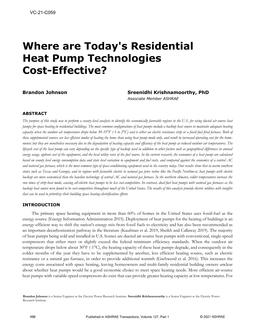Description
The purpose of this study was to perform a county-level analysis to identify the economically favorable regions in the U.S. for using ducted air-source heat pumps for space heating in residential buildings. The most common configurations of heat pumps include a backup heat source to maintain adequate heating capacity when the outdoor air temperature drops below 30-35°F (-1 to 2°C) and is either an electric resistance strip or a fossil-fuel fired furnace. Both of these supplemental sources are less efficient modes of heating the home than using heat pump mode only, and result in increased operating cost for the home-owner; but they are nonetheless necessary due to the degradation of heating capacity and efficiency of the heat pump at reduced outdoor air temperatures. The lifecycle cost of the heat pump can vary depending on the specific type of backup used in addition to other factors such as geographical differences in annual energy usage, upfront cost of the equipment, and the local utility rates of the fuel source. In the current research, the economics of a heat pump are calculated based on county level energy consumption data and state level variation in equipment and fuel costs, and compared against the economics of a central AC and natural gas furnace, which is the most common type of space-conditioning equipment used in the country today. Our results show that in warm southern states such as Texas and Georgia, and in regions with favorable electric to natural gas price ratios like the Pacific Northwest, heat pumps with electric backup are more economical than the baseline technology of central AC and natural gas furnace. In the northern climates, colder temperatures increase the run times of strip-heat mode, causing all-electric heat pumps to be less cost-competitive. In contrast, dual-fuel heat pumps with natural gas furnaces as the backup heat source were found to be cost-competitive throughout much of the United States. The results of this analysis provide electric utilities with insights that can be used to prioritize their building space heating electrification efforts.
Citation: 2021 Virtual Conference Papers
Product Details
- Published:
- 2021
- Number of Pages:
- 9
- Units of Measure:
- Dual
- File Size:
- 1 file , 1.5 MB
- Product Code(s):
- D-VC-21-C059




